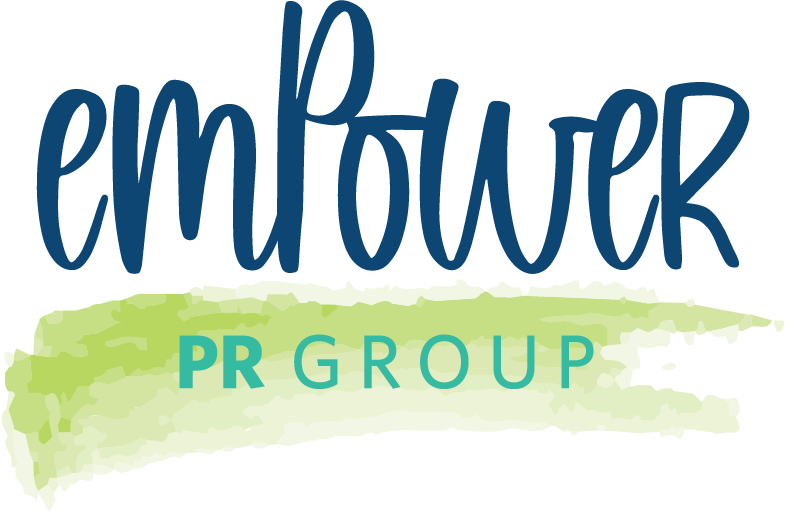I remember trudging into my local craft store for the umpteenth time pulling my blue rolling cart that I had purchased with my hard-earned money from my door wreath business. Instead of purchasing products that day, I was going to teach others what to do with the products that they could pick up any day they were feeling crafty. It was a day to create, and in my book, any day to create is a day that’s bound to be exciting.
My wreath business was never a business I dreamed of creating. It just, well, happened on accident but with purpose. You see, I had a book within me, and I so desperately needed to gift it to others. The message had been begging me to get out, but I wasn’t sure how to afford the book writing and publishing journey. Then, through a serendipitous series of events, my wreath business was born. It was that business — the one that was built from a love of creating — that taught me how to understand how the minds of my target audiences worked.
With loads of red, loosely woven burlap spools, a heart wreath frame, chevron ribbon and floral wire, I was set to help a few dozen people learn how to make something most had never attempted. The burlap heart wreath that they would walk out with that day would be a memento of their ability to tackle something they knew nothing about … and end up with an outcome that was likely well worth the hard work.
I had been to this craft store multiple times a week for several years straight, so I was well known as the wreath lady. I was fine with that because I was in my heaven when I was perusing burlap fabrics and gazing into the floral selections they had for the season. Many friendships were built from my creative business, but one in particular stuck.
I remember a cashier who had taken an interest in my blooming business as she would ask me for business tips at check out. She, too, was a creator, but her medium was wood slivers, and her craft was wood burnings. Her artistic eye created pure masterpieces. I was in awe of what she could do, and it was a pleasure to give her insights into how she could potentially grow her business.
That particular day, she was on break and decided to help me set up my space for the upcoming workshop. As we unpacked rolls of burlap and placed each person’s materials meticulously by their spot at the table, she made a comment that, to this day, I still remember. “Stephanie,” she asked. “Aren’t you afraid that if you teach people how to do something that you are trying to sell that they won’t want to purchase from you? Aren’t you worried that they will just make it themselves?”
In the beginning of hosting workshops, that fear of scarcity crept up but I realized that my worries — and that of my creative pupil — had no merit. Instead, something quite the opposite happened. Sure, the skillset I was teaching was one that could mean that I could lose business. Those in attendance could decide to make all the wreaths that their home would ever need. That definitely was a possibility. But it wasn’t reality, and I used the moment as an opportunity to share with her my insights.
“There are two types of people,” I explained. “Those that value time over money and those that value money over time.” She looked at me, perplexed, and I continued to explain what I had learned about my workshops … about my business … and about my target audience.
Some of your target audience will value time over money.
Early in my wreath business, I believed that those who would pay for my services wanted a finished piece. They wanted a beautiful custom-made creation to hang on their door front as a welcoming piece of art. They wanted something that they had a hand in selecting colors and design for, but they wanted my creative eye and my design aesthetic. They wanted me to create.
This subset of my target audience — those who were willing to invest in a custom wreath that they couldn’t pick up at their local craft store — were willing to invest in me and my work. They didn’t want to go to the store to peruse, hoping to select something that may fit their needs at a potentially lower price-point. They wanted to save time store hopping and was willing to invest in a custom piece made by yours truly. This group of people valued time (as they didn’t want to spend oodles of it traveling around to find a perfect wreath for their space) over money (since they were willing to invest in a custom, handmade piece to fit their needs).
Some of your target audience will value money over time.
But there was another subset of my target audience who, occasionally in passing, would ask if I would ever teach them how to make a wreath. I hadn’t ever thought of that! Teaching a skill sounded interesting. It sounded fun and like a new challenge to take on.
I was excited to give this concept a try for many reasons. From a business perspective, it made financial sense as I could teach 20 people to make a wreath in the same time I could create one wreath myself. So, in theory, I unlocked a new opportunity to scale my business. But what excited me most was the opportunity to create with others. You see, for me, creating is a form of therapy, and getting to create in community was something downright special.
That first workshop that I held, and the others that followed, proved to me that there was a whole group of people who were silently interested in my business, but was unsure about the financial investment in buying one of my creations. That group, instead, was willing to invest time in learning the skill. This subset of my target audience valued money (and the investment that they made with it) over time (as they were willing to take the time to learn something that they would likely use time and time again).
Don’t leave money on the table.
As I explained the way each of these subsets of my target audience thought — and how they valued time and money — I realized that what I learned from my wreath business had legs in any and all businesses. And, in fact, I’ve actually built my own business around the same concepts that a wreath business was built upon. As you contemplate how to engage and market to your target audience, reflect on these key questions. You may be surprised what they could stir up.
- Do you know the wants and needs of your target audience? Or, prior to that question, do you have clarity on who you target audience is? Understanding who needs your offerings — whether it’s your book or a derivative offering of your book’s message — will help you understand if you are currently meeting the wants and needs of those individuals.
- Take a deeper look at your target audience. When you lift up the façade, you are likely to see that there are various subsets within your target audience that have differing — and sometimes opposing — feelings, emotions, needs and wants. I’d venture to say that some are willing to invest in your product or service while others may want to but are fearful of the investment. Understanding how your target audience thinks and feels can help you move from merely marketing your business (or your book) to marketing a solution to a problem that they are faced with.
- Consider how you can take your book, your business or your message and adapt it for your various audience subsets. No, I’m not proposing that you create so many variations of your business offerings that you find yourself spinning out of control. Instead, may I suggest that you look at what you do offer and figure out if there are other opportunities to engage with those who want to work with you, but may want to do it a bit differently.
In any business, it’s important to focus on two things: doing what you love to do and doing what others will invest in. But many times we don’t realize that there may be a compromise — possibly even something that you didn’t even consider becomes a new thing you love and helps you reach a group of people that would never have considered investing in you otherwise.
From my experience in nonprofit marketing (which helped lay the seeds to my marketing career), I learned firsthand that when a potential client, customer, volunteer or donor says “no” to an opportunity, it doesn’t always mean no forever. It typically means “no” for right now. But when the timing is right and the investment is worth it, that original “no” may evolve into a resounding “yes”.
With this mindset shift in my wreath business, I was able to make or teach others to make over 1,000 wreaths in the course of two years! My reach extended, my business grew, and I uncovered a love for emPowering people with knowledge that they may not have known they wanted but were pumped to have.
Authors who are looking to sell more books … authorpreneurs who are looking grow sustainable businesses from their books’ messages … and businesses who are looking to leverage books as a tool for growth, my challenge to you is to take a hard look at your target audience and ask yourself, “how can I be a solution for those who value time over money and those who value money over time?”




